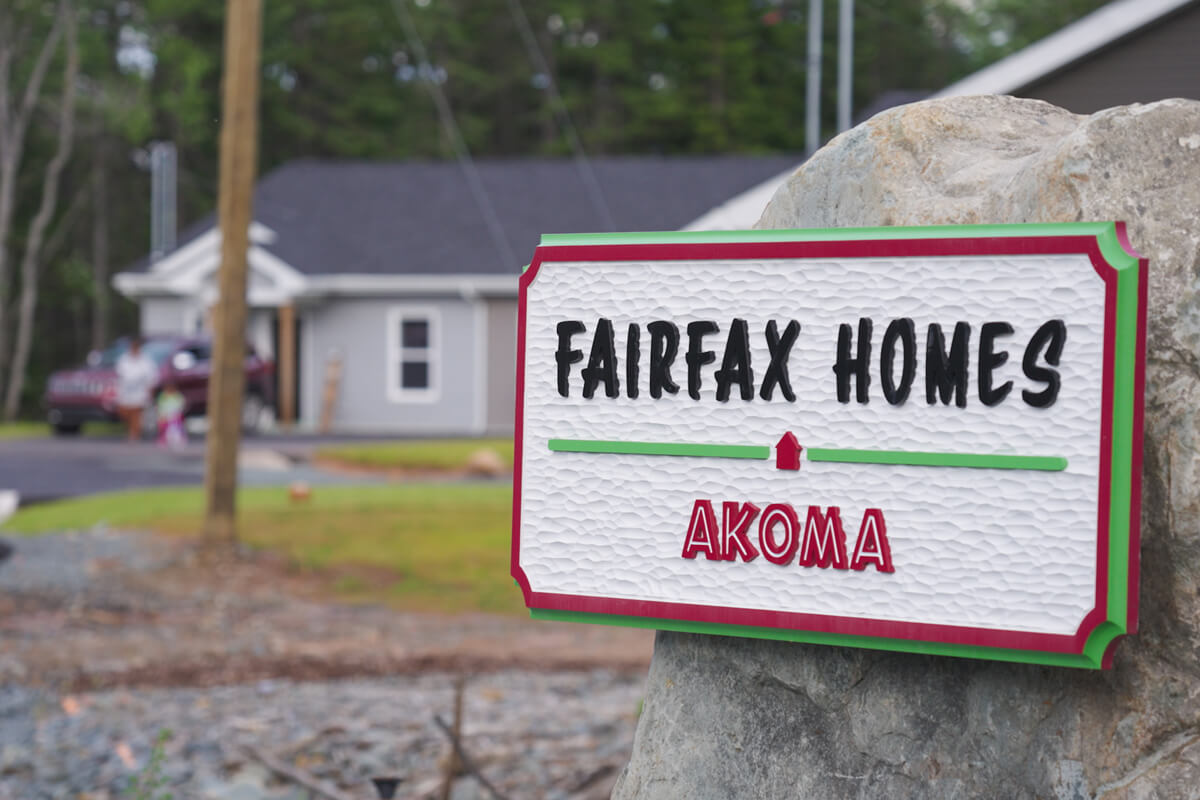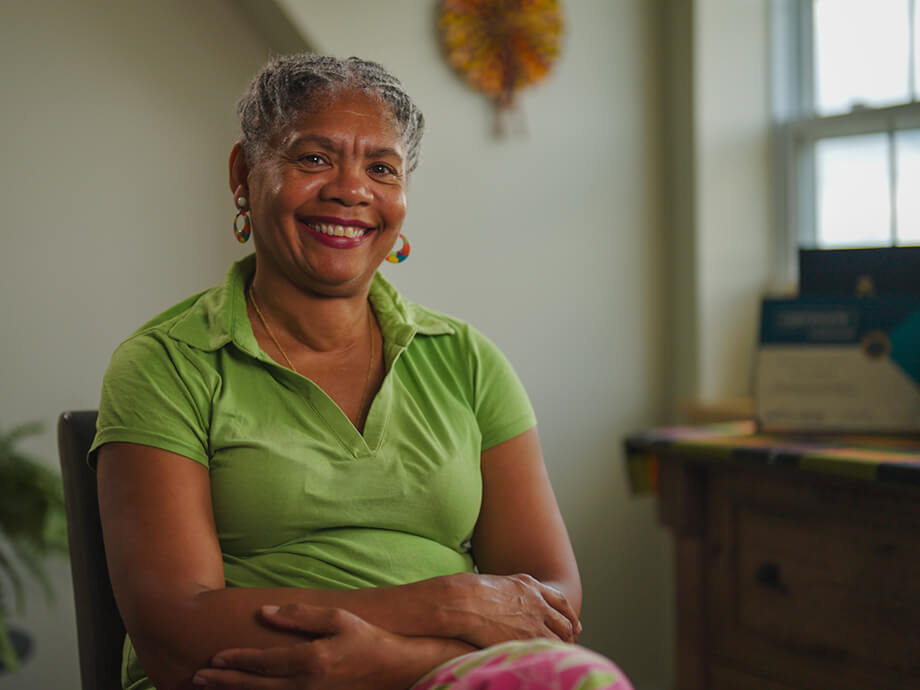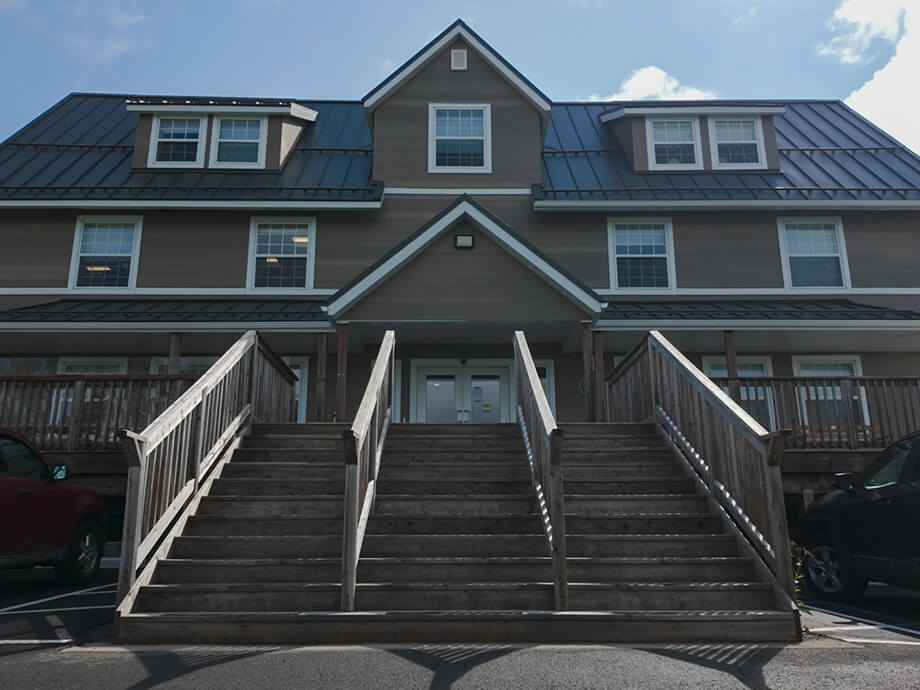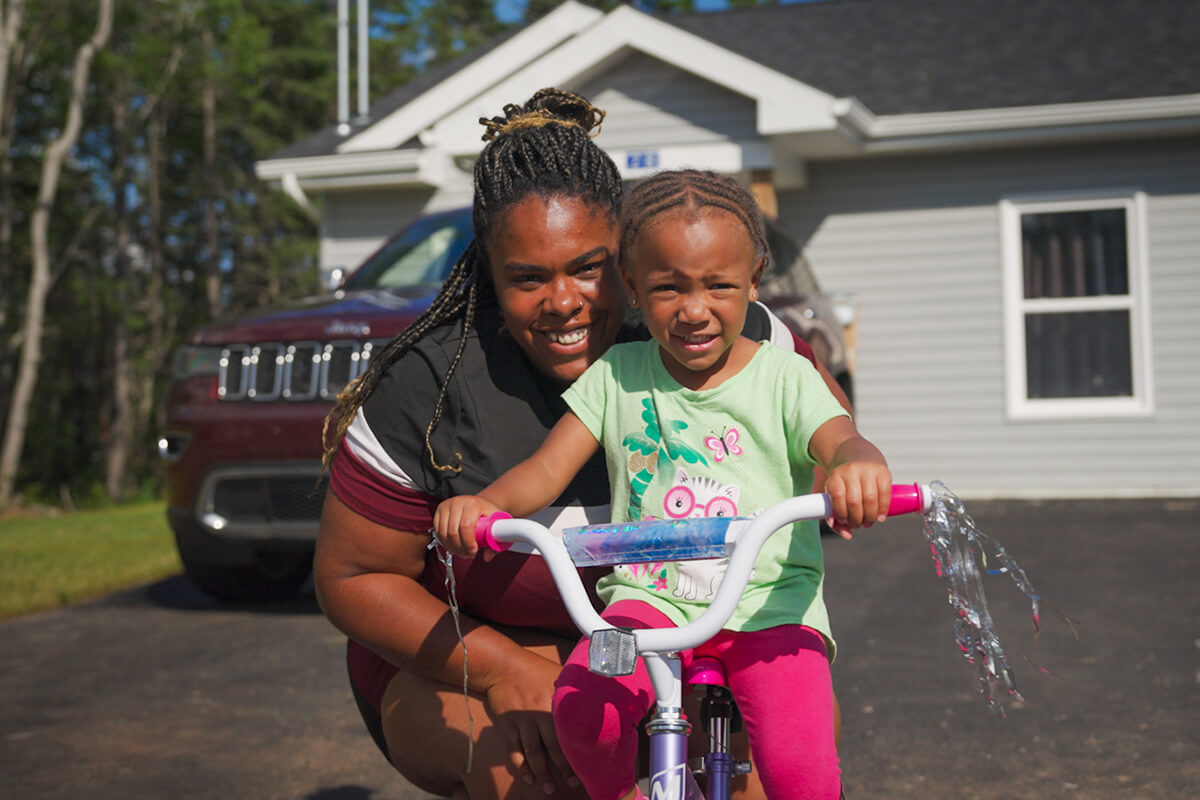November 28, 2024
(Visual: A bird’s-eye view of Halifax Harbour. The camera cuts to bird’s-eye views of Halifax Citadel and various other rooftops. The camera cuts to a view of daytime city traffic.)
[00:00:08]
Sunday Miller, Property Consultant, Akoma Holdings: Akoma means “heart.”
(Visual: The camera cuts to a house exterior adorned with street art of a Black person making peace signs with their hands. The camera cuts to a view of the Halifax waterfront showing three people paddling kayaks.)
[00:00:12]
Sunday: It’s a Ghanaian term that means “heart” and “compassion.”
(Visual: The camera cuts to a large bird’s eye-view of a wide-open river where three people are paddling kayaks. The camera cuts to a sign displaying the Akoma Holdings Incorporated logo. The camera cuts to a large house surrounded by a parking lot.)
[00:00:19]
Sunday: The history of Akoma... Initially, it was called the Nova Scotia Home for Colored Children, and it started back in the early 1900s, where there was a need for a place for children of African descent, because when they were orphaned, there was no place for them to go, other than to insane asylum or to jail.
(Text on screen: Sunday Miller, Property consultant – Akoma Holdings)
(Visual: The camera cuts to Sunday Miller sitting in an office. The camera cuts to a Canadian flag waving in the wind, then to a similar large house as previously seen, with the Canadian flag waving in the foreground. The camera cuts to close-ups of a book explaining the history of the Nova Scotia Home for Colored Children.)
[00:00:44]
Sunday: The Home was here until about ’68, when at that time, things were changing. They were no longer having orphanages. And so, they went from an orphanage to a family centre, and they moved down the way.
(Visual: The camera cuts to more close-ups of a book explaining the history of the Nova Scotia Home for Colored Children. The camera cuts to a bird’s-eye view of a large house and parking lot, surrounded by forest.)
[00:01:01]
Sunday: Akoma made the determination they wanted to develop the land. They had these 320 acres to develop. And so, they recognized that they needed a separate entity that would be responsible specifically for that property development piece.
(Visual: The camera cuts to a concept sketch of the map of the land showing the Akoma Holdings development. The camera cuts to a large bird’s-eye view of the forest surrounding a small residential development. The camera cuts to a sign displaying various logos of companies, including Akoma Holdings Incorporated.)
[00:01:19]
Sunday: Akoma Holdings is comprised of Kinney Place. Then, there is the Bauld Centre. We also have an amazing community garden, where people can come and rent plots. And then, part of Akoma Holdings is also Fairfax Homes, which is off of Dr. Donald Skeir Way, on Paris Lane.
(Visual: The camera cuts to a view of Kinney Place, the previously seen large house surrounded by a parking lot. The camera cuts to the Akoma Community Garden roadside sign. The camera cuts to a close-up of purple flowers, with a Canadian flag waving in the background. The camera cuts to shots of a Black man cutting a plant at its base and picking up vegetables he has pulled from the ground. The camera cuts to the entry sign of Fairfax Homes. The camera cuts to a moving bird’s-eye view of Fairfax Homes, the previously seen housing development surrounded by forest.)
[00:01:41]
Sunday: The decision to build affordable homes, permanent homes, was the result of the Rapid Housing Initiative that was announced, and we recognized that there is a huge need. The difference is that homelessness within the Black community looks a little bit different, because they’re not necessarily in shelters or on the street. They are couchsurfing.
(Visual: The camera cuts back to Sunday Miller speaking while sitting in an office. The camera cuts to views of a shipping container adorned with art featuring the word “Community” and various signifiers of social unity. The camera cuts to a close-up of a barrel collecting rainwater. The camera cuts to Sunday Miller working in her office.)
[00:02:02]
Sunday: And they may not admit that they’re homeless because: “I have a roof over my head. I’m staying at Auntie’s.” And then, once we had the homes built, the question is: OK, how do we determine who comes into the homes? We felt the simplest way to do that would be to connect with the shelters in the area.
(Visual: The camera cuts to close-ups of Sunday Miller’s hands on a computer keyboard and a miniature model of a house. The camera cuts to a view of the Dr. Donald Skeir Way street sign. The camera cuts to exterior views of Fairfax Homes. The camera cuts back to Sunday Miller speaking in an office. The camera cuts to a bird’s-eye view of Fairfax Homes and of the surrounding forest. The camera cuts to a sign displaying the logo of Akoma Family Centre.)
[00:02:30]
Jontelle Fraser: Where I was living, it was the top of a daycare. My landlord, she was contacted by the government, saying that she needs the space that I was in for afterschool care. So, it put me in a situation of: I had three months to find myself a place to live, with me and my two kids.
(Text on screen: Jontelle & Nakasia Fraser, Residents – Fairfax Homes)
(Visual: The camera cuts to an exterior view of a large residential building and a worn-out basketball net. The camera cuts to a close-up of a children’s playground. The camera cuts to Jontelle Fraser speaking in her kitchen, with young daughter, Nakasia, sitting in her lap. The camera cuts to a bird’s-eye view of Fairfax Homes and its surrounding forest.)
[00:02:48]
Jontelle: Before moving here, like, my goal was, by the time I’m 30, to be able to have myself a mortgage and a home of my own. I’m 28 and I have two years. I’m not saying that I can’t get there, but living here, it gives me more of that security of: OK, my rent’s affordable. I’m able to put money to the side and save.
(Visual: The camera cuts to a street-level view of a Fairfax Homes housing unit, with two cars parked outside. The camera cuts back to Jontelle and Nakasia Fraser in their kitchen. The camera cuts to views of Jontelle playing with Nakasia in the living room.)
[00:03:09]
Sunday: Part of Akoma’s vision is to create economic prosperity for the community, and we recognize that housing has always been a challenge within the Black community. And we would like to build healthy, good housing, so we can actually take that monkey off people’s back.
(Visual: The camera cuts back to Sunday Miller speaking in an office. The camera cuts to close-ups of awards presented to Akoma Holdings Inc. The camera cuts to a moving bird’s-eye view of Fairfax Homes. The camera cuts back to Jontelle and Nakasia playing in their living room.)
[00:03:34]
Jontelle: Being here, it helps me, and it secures me on knowing that, OK, I don’t have to worry or struggle. Where am I going to get my grocery money from? Where am I going to get my car payment money from? How do I pay daycare? Like, it’s just… It’s affordable. Like, it’s affordable living, which… It should be like this for everybody. But right now, being back here, it gives me that security of knowing that I have a roof over my kid’s head and that I’m able to provide for them after paying rent and everything else.
(Visual: The camera cuts to Jontelle helping Nakasia ride her bicycle outside of their Fairfax Homes unit. The camera cuts back to Jontelle speaking in her kitchen, with Nakasia sitting in her lap. The camera cuts to Nakasia riding her bicycle outside. The camera cuts to views of Jontelle and Nakasia entering their house and playing in the living room. The camera cuts to a bird’s eye-view of a multi-story residential building surrounded by forest and a parking lot.)
[00:04:11]
Sunday: Part of Akoma’s desire, its vision, its legacy: to help create generational wealth. To help change the conditions of people of African descent.
(Visual: The camera cuts back to Sunday Miller speaking in an office.)
[00:04:24]
Sunday: Once the housing situation is taken care of, then perhaps that will give them the opportunity to lift their head up and start having a dream, to start visioning a different life for themselves and their children.
(Visual: The camera cuts to a large bird’s-eye view of Fairfax Homes and its surrounding forest. The camera cuts to a view of the recently paved entry road to Fairfax Homes. The camera cuts to Nakasia running after a basketball outside her home, followed by Jontelle. The camera cuts to Jontelle helping Nakasia throw the ball into a basketball net.)
[00:04:39]
Jontelle: The way that I look at it is I feel like this is home. Like you can actually say that this is home, like “This is ours, and we have to make this our community.” And I wouldn’t ask for anything different, at this point in life right now. Until I can get myself situated to where I want to be, I’m happy here.
(Visual: The camera cuts back to Jontelle speaking in her kitchen, with Nakasia sitting in her lap. The camera cuts to views of Jontelle helping Nakasia ride her bicycle. The camera cuts to quick views of Akoma Community Garden and people gardening. The camera cuts to a low-angle view from the front stairs of the Kinney Place. The camera cuts to an exterior close-up of the Registered Heritage Property plaque from the Halifax Regional Municipality that says “Nova Scotia Home for Colored Children” and “1921” on it. The camera cuts back to Jontelle speaking in her kitchen, with Nakasia sitting in her lap. The camera cuts to Sunday Miller sitting in an office, looking at the camera. The camera cuts to Jontelle and Nakasia sitting in their kitchen, looking and smiling at the camera. The camera cuts to the CHMC SCHL and Government of Canada logos on a white background.)
At a glance
- Fairfax Homes is the first residential development by Akoma Holdings.
- The land on which the 8 homes were built has served African Nova Scotian children and families for more than a century.
- The development moves Akoma closer to its vision of economic prosperity and generational wealth for people of African descent.
- Thanks to the new development, Jontelle and her 2 children have found stability, affordability and community at their home on Paris Lane.
“Oh my gosh, trying to find affordable housing right now is just ridiculous,” says Jontelle, her 2-year daughter shifting quietly on her lap.
Nakasia just arrived home from daycare and eyes the curtain blowing gently against the open patio door. It’s a warm summer afternoon and it’s clear she would rather be outside.
“My son goes out every day and night playing basketball,” says Jontelle. “My daughter, as soon as she opens her eyes, ‘can I drive my bike?’”
It’s less than 6 months since Jontelle and her 2 children moved to Fairfax Homes, and they have already established new routines. This is their home — a place to live, grow and think about the future, and a very different scene to a year ago.

Uncertain times
“I was living above a daycare,” says Jontelle. “And then my landlord said she needed the space I was in for after school care … I had 3 months to find myself a place to live with my 2 kids.”
She found a temporary solution with Adsum, a shelter for women and children, but permanent housing proved difficult.
“Looking for a 3-bedroom apartment was 2 grand or more. I was like, I can’t. It’s either we eat, or we have no lights.”
When an Adsum case manager told Jontelle about a new development that was underway in Dartmouth, Jontelle was keen to hear more.
The project was Fairfax Homes. A first-of-its-kind development for Black Canadian families.

A history of heart and compassion
Located in Westphal, close to Dartmouth, Fairfax Homes is a neighbourhood of 8 2-bedroom homes for Black families in need.
The homes are designed in a cul-de-sac, encouraging a sense of community and security, and represent a natural next step for property owner Akoma Holdings.

“Akoma is a Ghanaian term that means heart … it is a symbol of love, goodwill, patience, faithfulness, endurance, and consistency,” says Sunday Miller, property consultant, Akoma Holdings.
“The history of Akoma is [that] initially it was called the Nova Scotia Home for Colored Children.” Sunday says in the early 1900s orphaned children of African descent had nowhere to go, “other than an insane asylum or to jail.”
The initial idea was to create a home that also served as an industrial school. A property in Halifax was chosen, furnished and ready to open when disaster struck. The Halifax explosion devastated the building. Fortunately, it was unoccupied, and no one was hurt.
In its place, the province bought a farm in Dartmouth and gifted the land to the Black community. A new orphanage was established, along with a school and a fully functioning farm. The home served the community until the late 1970s, when changing times prompted its closure.
A new vision
In 2014 Akoma Holdings was incorporated with a vision to develop the land.
“They had these 320 acres to develop and recognized they needed a separate entity that would be responsible for that property development piece.”

The site of the original home is now a business incubator, Kinney Place, named after the first superintendent of the school.
The former school is a community space, the Bauld Centre, named after H.G. Bauld who helped to establish the home.
A community garden and another building acquired by Akoma provide affordable rentable plots and office space.
Yet there was one key area that Akoma hadn’t yet explored – affordable homes.
Hidden homelessness
“The decision to build affordable homes, permanent homes, was the result of the Rapid Housing Initiative that was announced,” says Sunday.
“We knew from community engagement that the need was there … The difference is that homelessness in the Black community looks a little different. They are not necessarily in shelters or on the street, they are couch surfing … and they may not admit that they are homeless, because ‘I have a roof over my head, I’m staying at Auntie’s’.”
A planning committee was formed and determined the location, number, size and design of the homes.
…homelessness in the Black community looks a little different. They are not necessarily in shelters or on the street, they are couch surfing.
When the homes were complete, the question became “How do we determine who comes into the homes?”
In collaboration with local shelters, the qualifying criteria was identified — potential residents had to meet income limits and have children.
Unsurprisingly, there were many more people that fit the criteria, than Akoma had space for.

Community by design
Once residents moved in, the Fairfax community developed quickly and organically.
The transition was made easier thanks to a unique role, created by Akoma.
“We recognize that if you are homeless or you are struggling to be adequately housed for a long time that creates some level of trauma and so we have a family support worker to help them move forward,” says Sunday. This role provides the families with a wide variety of support from helping to set up their home, through to preparing for a job application or starting a business.

The cul-de-sac design and limited number of homes encouraged the neighbours to get to know each other. Some discovered they were related. Others take comfort in knowing there is always someone around to keep an eye on the children playing outside.
At their first BBQ, the residents took a group photo on Paris Lane, marking a new beginning for themselves, and for Akoma.
"Beyond survival, toward thriving."
Akoma’s new homes are a key part of their vision to create economic prosperity and generational wealth for people of African descent. Sunday says she is already seeing several residents thinking, “beyond survival, toward thriving.”
It’s not a community from East Preston raising my kids. It’s me doing it on my own.
For Jontelle, it has transformed her experience of being a single mother. Not only has it provided a safe, secure, environment in which to raise her family, she is able to maintain her ties to her nearby East Preston community, while establishing her independence.
“It’s not a community from East Preston raising my kids. It’s me doing it on my own.”

“Before moving here, my goal was by the time I’m 30 to be able to have myself a mortgage and home of my own. I’m 28 and I have 2 years. I’m not saying that I can’t get there but living at Fairfax homes gives me more of that security of OK, my rent’s affordable. I’m able to put money to the side and save.”
Having been incredibly patient, Nakasia slides off her mother’s lap and is already halfway out of the door to grab her bike. Jontelle follows closely behind, laughing as her daughter grabs her hand and pulls her along.
“I wouldn’t ask for anything different at this point in my life.”
Key facts
- Fairfax Homes by Akoma Holdings was funded by the Government of Canada’s Rapid Housing Initiative.
- Akoma Holdings was established in 2014. The organization owns and manages properties across 320 acres. These include Kinney Place, the Bauld Centre, the Akoma Family Centre and Fairfax Homes.






 Share via Email
Share via Email
